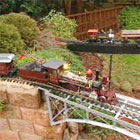Don visited railway enthusiast, David Fletcher and his wife Alison, who is a keen gardener. David has had a life-long interest in railways of the world and railway history. Alison had never heard of model railroading until she met David. In 1998, after many years of living in apartments, they bought a house and garden and began to create an amazing garden railway.
David has an international profile within the garden railway community, and he is a renowned expert on steam trains in general. He writes for Australian and American railway journals including Narrow Gauge Down Under, Fine Scale Railroader and Garden Railways. David also runs internet correspondence classes on model locomotive building. His online articles include locomotive background, history and construction drawings, and are followed up by interactive forums where students can ask questions and get feedback or research sources.
Model building
David has approximately 50 model trains. He buys some from the United States and builds others from scratch. Although he loves all engines, David has only modelled American locomotives. For each project he does around six months of research. He finds out where each locomotive was built, which company built it, how it was built and why and where it ran. The research involves sourcing original engineering drawings, because there are no coloured photographs of the trains and few drawings of how they were detailed.
House, garden and railway
The garden is around 15m x 9m (50′ x 30′), and the model railway covers most of this area. The locomotives are all ‘steam outline’ models, meaning they look like steam locomotives, but are powered by electricity. The lines can also support radio controlled battery operated models and fully live steam models, and both are often run. The fleet comprises mostly 3′ narrow gauge engines that ran in Colorado between 1875 and 1955.
The loop runs for approximately 76m (250′) of track. There are seven bridges, a lily pond and retaining walls which form the garden beds. The largest of the bridges is 17′ long and 5′ high, and is a scale model of an 1883 Colorado bridge. There are no buildings, stations or little towns. Alison chose most of the plants for the railway garden, including dwarf conifers, lavender, seaside daisies, native daisies, hellebores and lamb’s ears.
David and Alison find it very relaxing and mesmerising to sit and watch the railway and garden, while enjoying a cup of tea and biscuits. David says that his hobby is a bit nostalgic but that doesn’t mean he lives in the past. It is “about an understanding of the past, not just about toy trains”.
Further information
David’s plans can be seen on the internet at www.4largescale.com and www.mylargescale.com



